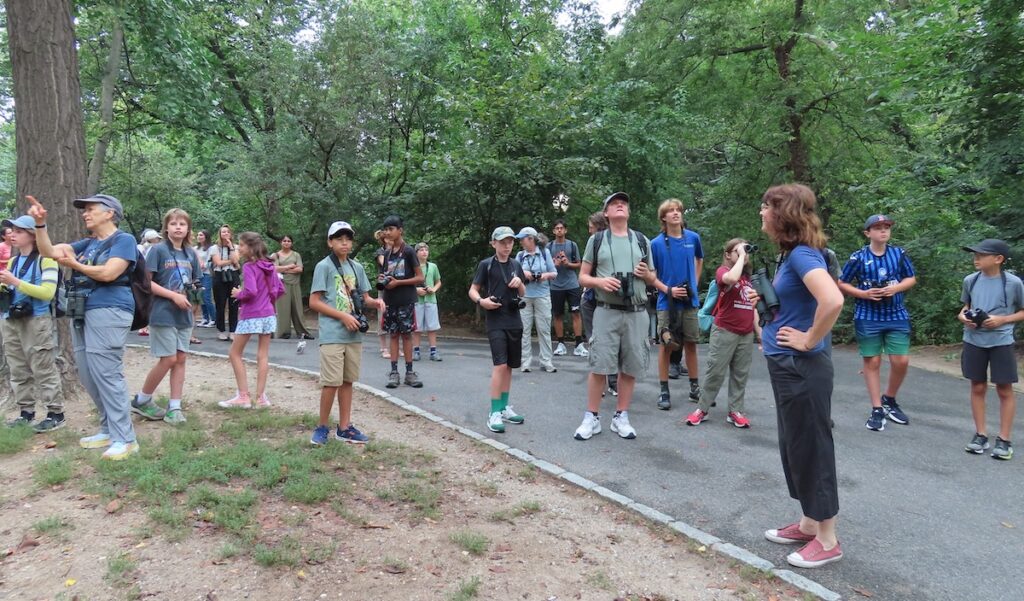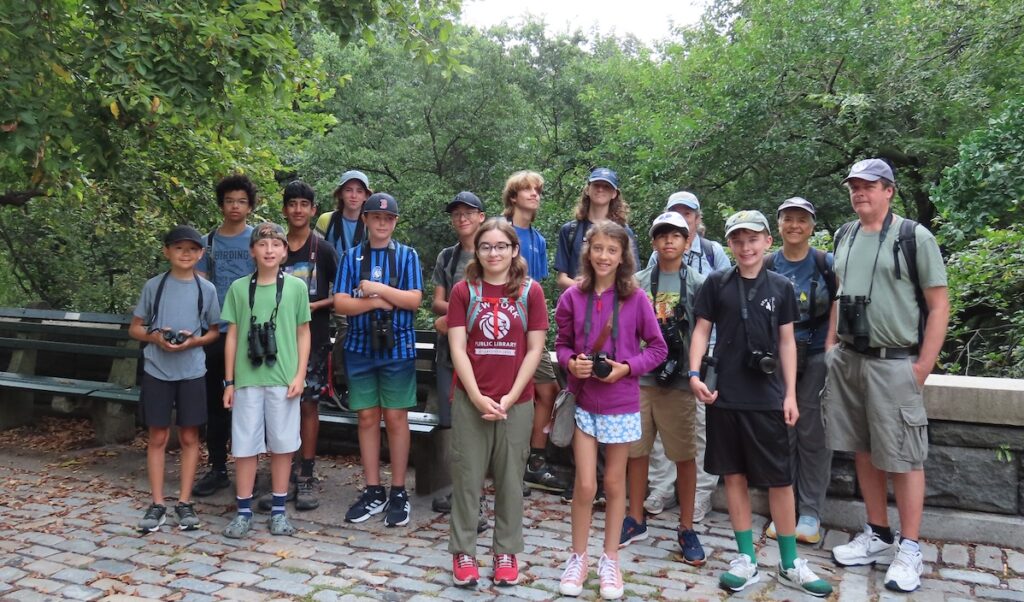Report by: John Dean, age 15
Registrars: Susan Joseph and Mary Beth Kooper
Participants: 35
Weather: 75 – 83°F, Light breeze N – SW
Bird Species: 35
This September, we went on a walk led by Kevin Sisco and Carine Mitchell from the Linnaean Society of New York in Central Park. This walk was a huge success and a great way to start the fall migration season.
Central Park was designed by Frederick Law Olmstead and Calvert Vaux and completed in 1858. Olmstead and Vaux are famous for designing other natural spaces around NYC, including Brooklyn’s Prospect Park. It should be noted that many people were displaced to build Central Park, including the predominantly black residents of Seneca Village, a settlement that provided an escape from the racism they faced in other parts of Manhattan.
Today, despite welcoming 42 million people each year, Central Park is a haven for birds, especially migrating songbirds during the spring and fall. Warblers, sparrows, tanagers, thrushes, flycatchers, and more are funneled into the park because it is one of the only habitats in the vast urban landscape of New York where they can rest on their long journeys. This creates a unique opportunity for birders, who can see their favorite migratory birds in high concentrations.
It wasn’t long before we spotted our first migratory bird of the walk: a Black-and-white Warbler foraging near the Park’s entrance. The Black-and-white Warbler is one of the more common migrants in NYC, but they’re still really fun to watch as they creep along the trunks and branches of trees looking for insects.
Eventually, we headed towards the Ramble. This area of the park is full of deep forests and winding paths. When you’re walking through it, it’s easy to forget you’re in one of the biggest cities in the world. With its dense undergrowth and abundant streams and ponds, the Ramble is the perfect habitat for migrating songbirds. We spotted a lot of these fall visitors on the walk: Common Yellowthroat, more Black-and-white warblers, American Redstart, Eastern Wood-Pewee, Black-throated Blue Warbler, Northern Waterthrush, a Great Crested Flycatcher, a Northern Parula, and a Baltimore Oriole. We also saw two species of vireo (Warbling and Red-eyed), which resemble warblers but with hooked, less delicate beaks. We were lucky enough to spot three species of thrush: Veery, Swainson’s, and the Wood Thrush.
Another highlight of the walk was seeing a flock of about ten Chimney Swifts flying above. These birds, which spend most of their lives flying, are common in New York during the summer and always fun to watch. We caught them just before they headed off on their long migration to the Amazon Rainforest.
We of course saw the usual year-round residents of the park: Carolina Wren, American Robin, Downy Woodpecker, Red-bellied Woodpecker, Northern Flicker, Mourning Dove, Mallard, and more. There was even some non-avian wildlife. We saw not one but two raccoons on this walk and a sloth (not a real sloth, a sloth keychain hanging in a tree).
This walk, which took place during the busy start of the school year, was the perfect reminder that even when you have a lot going on, taking a break to go outside and look for birds is always worth it. Thank you to Kevin and Carine from the Linnaean Society for leading this incredible walk, and everyone else who helped make it possible!
Sources:
160 Years of Central Park: A Brief History
Before Central Park: The Story of Seneca Village
Species Lists
Birds
Canada Goose
Mallard
Rock Pigeon (Feral Pigeon)
Mourning Dove
Chimney Swift
Herring Gull
Double-crested Cormorant
Red-tailed Hawk
Red-bellied Woodpecker
Downy Woodpecker
Northern Flicker
Eastern Wood-Pewee
Great Crested Flycatcher
Warbling Vireo
Red-eyed Vireo
Blue Jay
Carolina Wren
European Starling
Gray Catbird
Veery
Swainson’s Thrush
Wood Thrush
American Robin
House Sparrow
House Finch
Baltimore Oriole
Brown-headed Cowbird
Common Grackle
Northern Waterthrush
Black-and-white Warbler
Common Yellowthroat
American Redstart
Northern Parula
Black-throated Blue Warbler
Northern Cardinal



